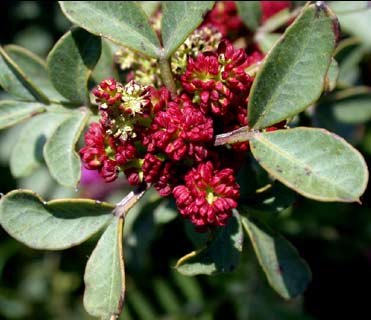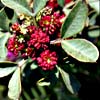Mastic tree (Lentisk) is a brachiate, dense and broad shrub. It usually reaches a height of 0.5 to 1.5 meters and the circumference of its crown can reach 4 meters. In exceptional cases it may grow as a tree of up to 5 meters. In many places it creates dense pillow-shaped shrubs. Near the seashore the shrubs are truncated and short. The plant contains a resin that emits a typical scent. A material for chewing was prepared from the resin, which was also used for seasoning and healing, which is the origin for the name of this species. The leaves are alternate, pinnate, with 4-6 leaflets arranged in pairs. They are 1.5-3 cm long. The leaflets are leathery, rounded at their tip with an entire margin. The leaves are often damaged by round galls that protrude from the leaf surface. The leaf axis is flat and winged.
Pistacia lentiscus blooms in the months of April-May. The flowers are single-sex and arranged as a panicle-like inflorescence. The shrub is dioecious, and male and female flowers do not grow together on the same individual. The male flower has 1-2 perianth lobes and 3-5 separate stamens, whose filaments are short and red. The male flowers grow as a sorus, and produce a large amount of pollen grains. The female flower has 2 bracteoles, 2-5 perianth loves. The style is short, the stigma at its tip is divided into 3 lobes. The ovary is superior. The tree is pollinated by wind. The fruits are arranged in limp racemes. The single fruit resembles a drupe, and contains a single seed. The fruit is green at first, then red, and the ripe fruit is black.
Pistacia lentiscus is common in the Mediterranean region in most of Israel, from the foothills of Mount Hermon to the margins of the desert. In the Sharon region, in the western foothills of Mount Carmel and along the seashore it creates a Carob-Mastic tree association. This association, in a somewhat different composition, also grows on the eastern margins of the Mediterranean region, on the eastern foothills of the Upper Galilee, the Gilboa, and East Samaria. The global distribution of the species is Mediterranean.
Written by Erga Aloni






